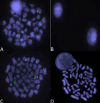Cryptic to conventional cytogenetics: Philadelphia-like ALL presenting with hypereosinophilia
- PMID: 39842907
- PMCID: PMC11795166
- DOI: 10.1136/bcr-2024-259811
Cryptic to conventional cytogenetics: Philadelphia-like ALL presenting with hypereosinophilia
Abstract
BCR::ABL1-like B-lymphoblastic leukaemia (B-ALL) neoplasms lack the BCR::ABL1 translocation but have a gene expression profile like BCR::ABL1 positive B-ALL. This includes alterations in cytokine receptors and signalling genes, such as CRLF2, ABL1, ABL2, JAK2, PDGFRB and EPOR Cases with CRLF2 rearrangements account for approximately 50% of cases of Philadelphia-like acute lymphoblastic leukaemia (Ph-like ALL), and the frequency of specific genomic lesions varies with ethnicity such that IGH::CRLF2 translocations are more common in Hispanics and Native Americans.We report two cases of BCR::ABL1-like ALL, with significant eosinophilia. A Hispanic man in his early 20s and a Hispanic woman in her 50s presented with leukocytosis and eosinophilia. Bone marrow flow cytometry revealed lymphoblasts expressing CD19, CD10, partial CD20, CD22, CD79a, CD38, CD34, TdT and HLA-DR. Examination of the bone marrow biopsy and aspirate exhibited a hypercellular bone marrow with increased blasts and elevated eosinophils. Fluorescence in situ hybridisation (FISH) demonstrated a cryptic chromosomal rearrangement between the X chromosome and chromosome 14 at breakpoints involving IGH at 14q32 and CRLF2 at Xp22.33, t(X;14)(p22.33; q32).These findings confirmed the diagnosis of BCR::ABL1-like B-ALL with IGH::CRLF2 rearrangement. One patient (man) attained complete remission with induction therapy using the paediatric CALGB 10403 protocol, while the other patient (woman) had a poor outcome after receiving a hyper-fractionated cyclophosphamide, vincristine, doxorubicin and dexamethasone regimen. These two cases demonstrate an unusual presentation of BCR::ABL1-like B-ALL and emphasise the importance of appropriate cytogenetic studies for correct diagnosis. When treated with conventional chemotherapy, these cases carry a poor prognosis and might require allogeneic transplantation.
Keywords: Cancer - see Oncology; Haematology (incl blood transfusion); Malignant and Benign haematology; Pathology.
© BMJ Publishing Group Limited 2025. Re-use permitted under CC BY-NC. No commercial re-use. See rights and permissions. Published by BMJ Group.
Conflict of interest statement
Competing interests: None declared.
Figures
Similar articles
-
Judicious use of precise fluorescence in situ hybridisation panels guided by population prevalence may assist pragmatic detection of clinically targetable Philadelphia chromosome-like acute lymphoblastic leukaemia fusions: a systematic review.Pathology. 2024 Dec;56(7):931-941. doi: 10.1016/j.pathol.2024.08.001. Epub 2024 Sep 7. Pathology. 2024. PMID: 39304495
-
Dasatinib and CAR T-Cell Therapy in Newly Diagnosed Philadelphia Chromosome-Positive Acute Lymphoblastic Leukemia: A Nonrandomized Clinical Trial.JAMA Oncol. 2025 Jun 1;11(6):625-629. doi: 10.1001/jamaoncol.2025.0674. JAMA Oncol. 2025. PMID: 40244598 Free PMC article. Clinical Trial.
-
Masked by eosinophils: a cryptic presentation of pediatric B-ALL with IGH rearrangement.J Hematop. 2025 Jul 14;18(1):33. doi: 10.1007/s12308-025-00649-3. J Hematop. 2025. PMID: 40658287
-
Multilineage involvement in KMT2A-rearranged B acute lymphoblastic leukaemia: cell-of-origin, biology, and clinical implications.Histopathology. 2024 Aug;85(2):310-316. doi: 10.1111/his.15203. Epub 2024 Apr 30. Histopathology. 2024. PMID: 38686611 Free PMC article.
-
Does presence of complex translocations involving BCR::ABL1 in chronic myeloid leukemia affect the response rate to tyrosine kinase inhibitors? A systematic review of the literature.Ann Diagn Pathol. 2024 Aug;71:152303. doi: 10.1016/j.anndiagpath.2024.152303. Epub 2024 Apr 9. Ann Diagn Pathol. 2024. PMID: 38636337
References
Publication types
MeSH terms
Substances
LinkOut - more resources
Full Text Sources
Medical
Research Materials
Miscellaneous

